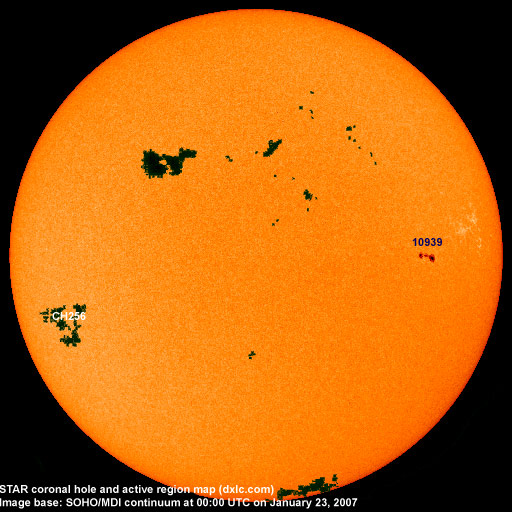

Last major update issued on January 23, 2007 at 05:15 UTC.
[Solar and
geomagnetic data - last month (updated daily)]
[Solar wind and
electron fluence charts (updated daily)
[Solar cycles 21-23
(last update January 11, 2007)]
[Solar cycles 1-20]
[Graphical comparison
of cycles 21, 22 and 23 (last update January 11, 2007)]
[Graphical
comparison of cycles 2, 10, 13, 17, 20 and 23 (last update January 11, 2007)]
[Historical solar and
geomagnetic data charts 1954-2005 (last update March 3, 2006)]
[Archived reports
(last update December 18, 2006)]
The geomagnetic field was quiet on January 22. Solar wind speed ranged between 410 and 467 km/s (all day average 448 km/s - decreasing 47 km/s compared to the previous day).
Solar flux measured at 20h UTC on 2.8 GHz was 78.5. The planetary A index was 3 (STAR Ap - based on the mean of three hour interval ap indices: 2.8). Three hour interval K indices: 10111011 (planetary), 10211110 (Boulder).
The background x-ray flux is at the class A1 level.
At midnight there was 1 spotted region on the visible solar disk. The solar flare activity level was very low. No C class events were recorded during the day.
Region 10939 lost a few small spots. An intermediate positive polarity spot is close to the leading negative polarity spots. C flares are possible.
January 20-22: No obvious partly or fully Earth directed CMEs were detected in LASCO imagery.
Coronal hole
history (since late October 2002)
Compare today's report to the situation one solar rotation ago:
28
days ago
27
days ago
26
days ago
A recurrent coronal hole (CH256) in the southern hemisphere will likely rotate into an Earth facing position on January 21-24.

Processed SOHO/EIT 195 image at 00:00 UTC on January 23. The darkest areas on the solar disk are likely coronal holes.
The geomagnetic field is expected to be mostly quiet on January 23-28.
| Coronal holes (1) | Coronal mass ejections (2) | M and X class flares (3) |
1) Effects from a coronal hole could reach Earth
within the next 5 days. When the high speed stream has arrived the
color changes to green.
2) Effects from a CME are likely to be observed at Earth within 96
hours.
3) There is a possibility of either M or X class flares within the next
48 hours.
Green: 0-20% probability, Yellow: 20-60% probability, Red: 60-100% probability.
Monitoring has been temporarily suspended (as of January 1, 2007).

Compare to the previous day's image.
Data for all numbered solar regions according to the Solar Region Summary provided by NOAA/SEC. Comments are my own, as is the STAR spot count (spots observed at or inside a few hours before midnight) and data for regions not numbered by SEC or where SEC has observed no spots. SEC active region numbers in the table below and in the active region map above are the historic SEC/USAF numbers.
| Active region | Date numbered | SEC spot count |
STAR spot count |
Location at midnight | Area | Classification | Comment |
|---|---|---|---|---|---|---|---|
| 10938 | 2007.01.13 | N04W53 | |||||
| 10939 | 2007.01.20 | 13 | 14 | S04W43 | 0120 | DSO | classification was DAI at midnight, area 0200 |
| S691 | 2007.01.17 | S01W63 | plage | ||||
| S692 | 2007.01.18 | N11W61 | plage | ||||
| Total spot count: | 13 | 14 | |||||
| SSN: | 23 | 24 | |||||
| Month | Average solar flux at Earth |
International sunspot number | Smoothed sunspot number |
|---|---|---|---|
| 2000.04 | 184.2 | 125.5 | 120.8 cycle 23 sunspot max. |
| 2000.07 | 202.3 | 170.1 | 119.8 |
| 2001.12 | 235.1 | 132.2 | 114.6 (-0.9) |
| 2005.11 | 86.3 | 18.0 | 24.9 (-0.6) |
| 2005.12 | 90.7 | 41.1 | 23.0 (-1.9) |
| 2006.01 | 83.4 | 15.3 | 20.8 (-2.2) |
| 2006.02 | 76.5 | 4.9 | 18.6 (-2.2) |
| 2006.03 | 75.4 | 10.6 | 17.3 (-1.3) |
| 2006.04 | 89.0 | 30.2 | 17.1 (-0.2) |
| 2006.05 | 80.9 | 22.2 | 17.3 (+0.2) |
| 2006.06 | 76.5 | 13.9 | 16.3 (-1.0) |
| 2006.07 | 75.7 | 12.2 | (15.0 predicted, -1.3) |
| 2006.08 | 79.0 | 12.9 | (14.9 predicted, -0.1) |
| 2006.09 | 77.8 | 14.5 | (14.7 predicted, -0.2) |
| 2006.10 | 74.3 | 10.4 | (13.5 predicted, -1.2) |
| 2006.11 | 86.3 | 21.5 | (12.1 predicted, -1.4) |
| 2006.12 | 84.5 | 13.6 | (11.7 predicted, -0.4) |
| 2007.01 | 83.5 (1) | 22.6 (2) | (11.9 predicted, +0.2) |
1) Running average based on the
daily 20:00 UTC observed solar flux
value at 2800 MHz.
2) Unofficial, accumulated value based on the Boulder (NOAA/SEC)
sunspot number. The official international sunspot number is typically
30-50% lower.
This report has been prepared by Jan Alvestad. It is based partly on my own observations and analysis, and partly on data from some of these solar data sources. All time references are to the UTC day. Comments and suggestions are always welcome.
| [DX-Listeners' Club] |